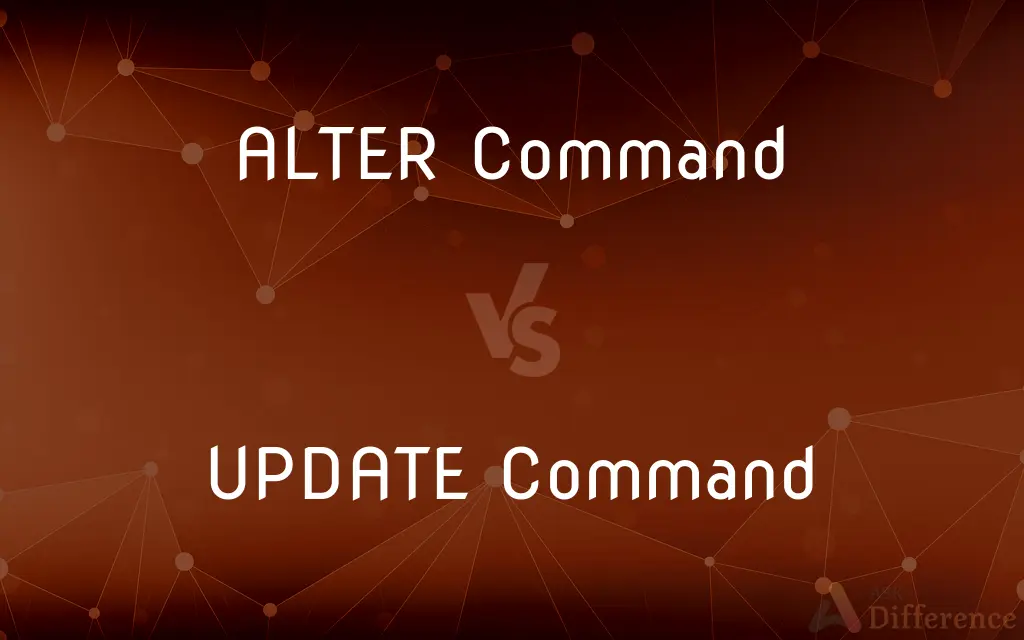ALTER Command vs. UPDATE Command — What's the Difference?
By Tayyaba Rehman — Published on January 24, 2024
ALTER Command modifies the structure of a database table, while UPDATE Command changes the data within the table rows.

Difference Between ALTER Command and UPDATE Command
Table of Contents
ADVERTISEMENT
Key Differences
ALTER Command is used in SQL to change the structure of a database table, like adding, deleting, or modifying columns. UPDATE Command, on the other hand, is utilized to modify the existing data within the table rows without altering the table's structure.
ALTER Command can be used to change the data type of a column, an essential tool for database schema evolution. In contrast, UPDATE Command affects the row content, allowing changes to the values stored in the table's columns.
ALTER Command is key in initial database design and subsequent modifications, such as adding indexes or changing constraints. UPDATE Command is predominantly used in the routine management of data, adjusting values as needed.
ALTER Command does not directly affect the data or content of the rows, but rather the framework in which the data is stored. UPDATE Command, conversely, directly changes the data, which can be filtered with conditions using the WHERE clause.
In terms of database administration, ALTER Command is more about structural maintenance and optimization. UPDATE Command is more about data accuracy and relevance, ensuring the data remains current and valid.
ADVERTISEMENT
Comparison Chart
Function
Modifies table structure
Modifies data within rows
Typical Use
Adding/deleting columns, changing data types
Changing values in existing rows
Impact on Database Schema
Directly changes schema
Does not change schema
Relation to Data
Does not affect existing data content
Directly affects existing data content
Common Usage Scenario
Database design and modification
Routine data management and updates
Compare with Definitions
ALTER Command
Schema Evolution Tool: Facilitates database growth.
ALTER TABLE users ADD CONSTRAINT pk_users PRIMARY KEY (id);
UPDATE Command
Data Modifier: Alters data in table rows.
UPDATE orders SET status = 'Shipped' WHERE order_id = 123;
ALTER Command
Structure Modifier: Changes table design.
ALTER TABLE students ADD COLUMN birth_date DATE;
UPDATE Command
Data Relevance Maintainer: Keeps table data current.
UPDATE accounts SET last_login = CURRENT_DATE WHERE user_id = 456;
ALTER Command
Column Manipulator: Adds, deletes, or modifies columns.
ALTER TABLE employees DROP COLUMN salary;
UPDATE Command
Row Value Updater: Changes specific values in rows.
UPDATE employees SET department = 'Marketing' WHERE department = 'Sales';
ALTER Command
Data Type Changer: Alters the data type of columns.
ALTER TABLE orders ALTER COLUMN price DECIMAL(10,2);
UPDATE Command
Conditional Data Changer: Updates data based on conditions.
UPDATE products SET price = price * 1.1 WHERE discontinued = 0;
ALTER Command
Index and Constraint Modifier: Adds or removes indexes and constraints.
ALTER TABLE products ADD INDEX (category_id);
UPDATE Command
Batch Data Editor: Alters multiple rows simultaneously.
UPDATE students SET enrolled = 0 WHERE graduation_year < 2023;
Common Curiosities
Does UPDATE Command affect the table's structure?
No, UPDATE Command changes the data within the table without altering its structure.
What's the purpose of the UPDATE Command?
UPDATE Command is used to modify existing data in a database table's rows.
When should I use the ALTER Command?
Use ALTER Command when you need to change the structure of a table, like adding a new column.
Can ALTER Command change the data in a column?
No, ALTER Command changes the column structure, not the data within it.
Can I use ALTER Command to rename a column?
Yes, ALTER Command can be used to rename a column in a table.
What happens if I use ALTER Command without specifying a column?
Using ALTER Command without specifying a column will result in an error; it needs specific column details to operate.
Does ALTER Command require specific privileges in a database?
Yes, altering a table typically requires higher privileges due to its impact on the database structure.
Can ALTER Command add a primary key to a table?
Yes, ALTER Command can be used to add a primary key to an existing table.
Is it possible to update multiple rows at once with UPDATE Command?
Yes, UPDATE Command can modify multiple rows simultaneously based on specified conditions.
Is ALTER Command reversible?
Depending on the change, some ALTER Command actions can be reversed, but others, like dropping a column, cannot.
Can I use both ALTER and UPDATE Commands on the same table?
Yes, you can use both commands on the same table, but for different purposes: ALTER for structural changes and UPDATE for data modifications.
Can UPDATE Command be used with a WHERE clause?
Absolutely, the WHERE clause in UPDATE Command specifies which rows should be updated.
What is the risk of using UPDATE Command without a WHERE clause?
Using UPDATE Command without a WHERE clause can unintentionally modify all rows in the table.
Can UPDATE Command change the data type of a column?
No, UPDATE Command cannot change the data type of a column; it only updates the values within existing data types.
How can I ensure data integrity when using UPDATE Command?
Use transaction control and careful WHERE clause conditions to ensure data integrity with UPDATE Command.
Share Your Discovery

Previous Comparison
Nike Air Max vs. Nike Air Force
Next Comparison
Microsoft Xbox One S vs. Microsoft Xbox One XAuthor Spotlight
Written by
Tayyaba RehmanTayyaba Rehman is a distinguished writer, currently serving as a primary contributor to askdifference.com. As a researcher in semantics and etymology, Tayyaba's passion for the complexity of languages and their distinctions has found a perfect home on the platform. Tayyaba delves into the intricacies of language, distinguishing between commonly confused words and phrases, thereby providing clarity for readers worldwide.













































